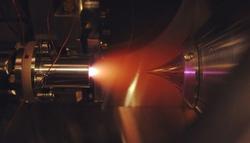Unique insight in the evolution of molecules in interstellar space
The moment where the discharged molecules expand in the vacuum chamber and cool down. The cone on the right has an orifice that selects the coldest part before the mixture is investigated using laser spectroscopy
Unique insight in the evolution of molecules in interstellar space
Large polycyclic aromatic hydrocarbons (PAHs) are the most abundant complex molecules in the interstellar medium; they are detected in the birthplace regions of new stars and planets. Despite their abundance their possible formation pathways from small molecular species are still elusive.
FELIX researchers used the free-electron laser to reveal a new reaction mechanism and identify specific structures during the growth of PAHs in interstellar space. The findings are important for the field of astrochemistry, as the new reaction pathways can be used to understand the evolution of molecules in space and the composition of material in star and planet forming regions.
Method
Much experimental knowledge so far has been based on combustion chemistry: by supplying heat to a reactive sample, a gas phase chemical reaction is initiated. Disadvantage of this method is that the PAHs cannot grow very large in the gas phase and conditions are hard to compare to interstellar environments.
FELIX researchers therefore initiated gas phase reactions by an electrical discharge. Electrical energy is supplied to stable molecules that then fragment and undergo a reaction with other molecules. In this way, the PAHs can grow larger in the gas phase. They cooled down the reaction mixture and charged the neutral products using UV lasers to observe which new and exotic species are formed. The charged molecules are separated by their mass, revealing that much larger PAHs are formed, sometimes more than three times the original mass. The free-electron laser FELIX was essential to record infrared spectroscopic fingerprints for all individual masses and to find out what particular structure the intermediates and products have. Using quantum chemical calculations these fingerprints were assigned to specific molecular structures. In this way the new reaction mechanism was revealed.
Read the publication

